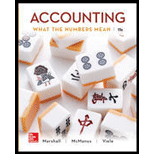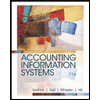
Accounting: What the Numbers Mean
11th Edition
ISBN: 9781259535314
Author: David Marshall, Wayne William McManus, Daniel Viele
Publisher: McGraw-Hill Education
expand_more
expand_more
format_list_bulleted
Concept explainers
Textbook Question
Chapter 5, Problem 5.35P
Problem 5.35
LO 7
Effects of inventory errors
- If the beginning balance of the Inventory account and the cost of items purchased or made during the period are correct, but an error resulted in overstating the firm’s ending inventory balance by $15,000, how would the firm’s cost of goods sold be affected? Explain your answer by drawing T-accounts for the Inventory and Cost of Goods Sold accounts and entering amounts that illustrate the difference between correctly stating and overstating the ending inventory balance.
- If management wanted to understate profits, would ending inventory be understated or overstated? Explain your answer.
Expert Solution & Answer
Want to see the full answer?
Check out a sample textbook solution
Students have asked these similar questions
Get correct answer general accounting question
The Ford Company developed the following
Do fast answer of this accounting questions
Chapter 5 Solutions
Accounting: What the Numbers Mean
Ch. 5 - Prob. 5.1MECh. 5 - Prob. 5.2MECh. 5 - Mini-Exercise 5.3 LO 5 Accounts receivable, bad...Ch. 5 - Mini-Exercise 5.4 LO 5 Bad debts...Ch. 5 - Mini-Exercise 5.5 LO 7, 8 Cost flow...Ch. 5 - Mini-Exercise 5.6 LO 7, 8 Cost flow...Ch. 5 - Prob. 5.7ECh. 5 - Prob. 5.8ECh. 5 - Prob. 5.9ECh. 5 - Prob. 5.10E
Ch. 5 - Exercise 5.11 LO 5 Bad debts analysis-Allowance,...Ch. 5 - Exercise 5.12 LO 5 Bad debts analysis-Allowance...Ch. 5 - Exercise 5.13 LO 5 Cash discounts-ROI Annual...Ch. 5 - Prob. 5.14ECh. 5 - Exercise 5.15 LO 6 Notes receivable-interest...Ch. 5 - Exercise 5.16 LO 6 Notes receivable-interest...Ch. 5 - Exercise 5.17 LO 7, 8 LIFO versus FIFO-matching...Ch. 5 - Prob. 5.18ECh. 5 - Prob. 5.19ECh. 5 - Prob. 5.20ECh. 5 - Exercise 5.21 LO 5, 6, 8 Transaction...Ch. 5 - Exercise 5.22 LO 5. 8, 10 Transaction...Ch. 5 - Exercise 5.23 LO 5, 6, 7 Transaction...Ch. 5 - Exercise 5.24 LO 7, 8, 10 Transaction...Ch. 5 - Prob. 5.25PCh. 5 - Prob. 5.26PCh. 5 - Problem 5.27 LO 5 Bad debts analysis-Allowance...Ch. 5 - Problem 5.28 LO 5 Bad debts analysis-Allowance...Ch. 5 - Problem 5.29 LO 5 Analysis of accounts receivable...Ch. 5 - Problem 5.30 LO 5 Analysis of accounts receivable...Ch. 5 - Problem 5.31 LO 7, 8 Cost flow assumptions-FIFO...Ch. 5 - Problem 5.32 LO 7, 8 Cost flow assumptions-FIFO,...Ch. 5 - Prob. 5.33PCh. 5 - Prob. 5.34PCh. 5 - Problem 5.35 LO 7 Effects of inventory errors If...Ch. 5 - Prob. 5.36PCh. 5 - Case 5.37 LO 5, 7, 8 Focus company-accounts...Ch. 5 - Case 5.38
LO 5, 7
Comparative analysis of current...
Knowledge Booster
Learn more about
Need a deep-dive on the concept behind this application? Look no further. Learn more about this topic, accounting and related others by exploring similar questions and additional content below.Similar questions
- Need help with this question solution general accountingarrow_forwardchoose best answerarrow_forwardIngram Enterprises has variable expenses equal to 65% of sales. At a $500,000 sales level, the degree of operating leverage is 4.5. If sales increase by $50,000, what will be the new degree of operating leverage? please provide answerarrow_forward
arrow_back_ios
SEE MORE QUESTIONS
arrow_forward_ios
Recommended textbooks for you
 Individual Income TaxesAccountingISBN:9780357109731Author:HoffmanPublisher:CENGAGE LEARNING - CONSIGNMENT
Individual Income TaxesAccountingISBN:9780357109731Author:HoffmanPublisher:CENGAGE LEARNING - CONSIGNMENT Cornerstones of Financial AccountingAccountingISBN:9781337690881Author:Jay Rich, Jeff JonesPublisher:Cengage Learning
Cornerstones of Financial AccountingAccountingISBN:9781337690881Author:Jay Rich, Jeff JonesPublisher:Cengage Learning Auditing: A Risk Based-Approach (MindTap Course L...AccountingISBN:9781337619455Author:Karla M Johnstone, Audrey A. Gramling, Larry E. RittenbergPublisher:Cengage Learning
Auditing: A Risk Based-Approach (MindTap Course L...AccountingISBN:9781337619455Author:Karla M Johnstone, Audrey A. Gramling, Larry E. RittenbergPublisher:Cengage Learning Financial & Managerial AccountingAccountingISBN:9781285866307Author:Carl Warren, James M. Reeve, Jonathan DuchacPublisher:Cengage Learning
Financial & Managerial AccountingAccountingISBN:9781285866307Author:Carl Warren, James M. Reeve, Jonathan DuchacPublisher:Cengage Learning Accounting Information SystemsFinanceISBN:9781337552127Author:Ulric J. Gelinas, Richard B. Dull, Patrick Wheeler, Mary Callahan HillPublisher:Cengage Learning
Accounting Information SystemsFinanceISBN:9781337552127Author:Ulric J. Gelinas, Richard B. Dull, Patrick Wheeler, Mary Callahan HillPublisher:Cengage Learning Financial Accounting: The Impact on Decision Make...AccountingISBN:9781305654174Author:Gary A. Porter, Curtis L. NortonPublisher:Cengage Learning
Financial Accounting: The Impact on Decision Make...AccountingISBN:9781305654174Author:Gary A. Porter, Curtis L. NortonPublisher:Cengage Learning

Individual Income Taxes
Accounting
ISBN:9780357109731
Author:Hoffman
Publisher:CENGAGE LEARNING - CONSIGNMENT

Cornerstones of Financial Accounting
Accounting
ISBN:9781337690881
Author:Jay Rich, Jeff Jones
Publisher:Cengage Learning

Auditing: A Risk Based-Approach (MindTap Course L...
Accounting
ISBN:9781337619455
Author:Karla M Johnstone, Audrey A. Gramling, Larry E. Rittenberg
Publisher:Cengage Learning

Financial & Managerial Accounting
Accounting
ISBN:9781285866307
Author:Carl Warren, James M. Reeve, Jonathan Duchac
Publisher:Cengage Learning

Accounting Information Systems
Finance
ISBN:9781337552127
Author:Ulric J. Gelinas, Richard B. Dull, Patrick Wheeler, Mary Callahan Hill
Publisher:Cengage Learning

Financial Accounting: The Impact on Decision Make...
Accounting
ISBN:9781305654174
Author:Gary A. Porter, Curtis L. Norton
Publisher:Cengage Learning
INVENTORY & COST OF GOODS SOLD; Author: Accounting Stuff;https://www.youtube.com/watch?v=OB6RDzqvNbk;License: Standard Youtube License